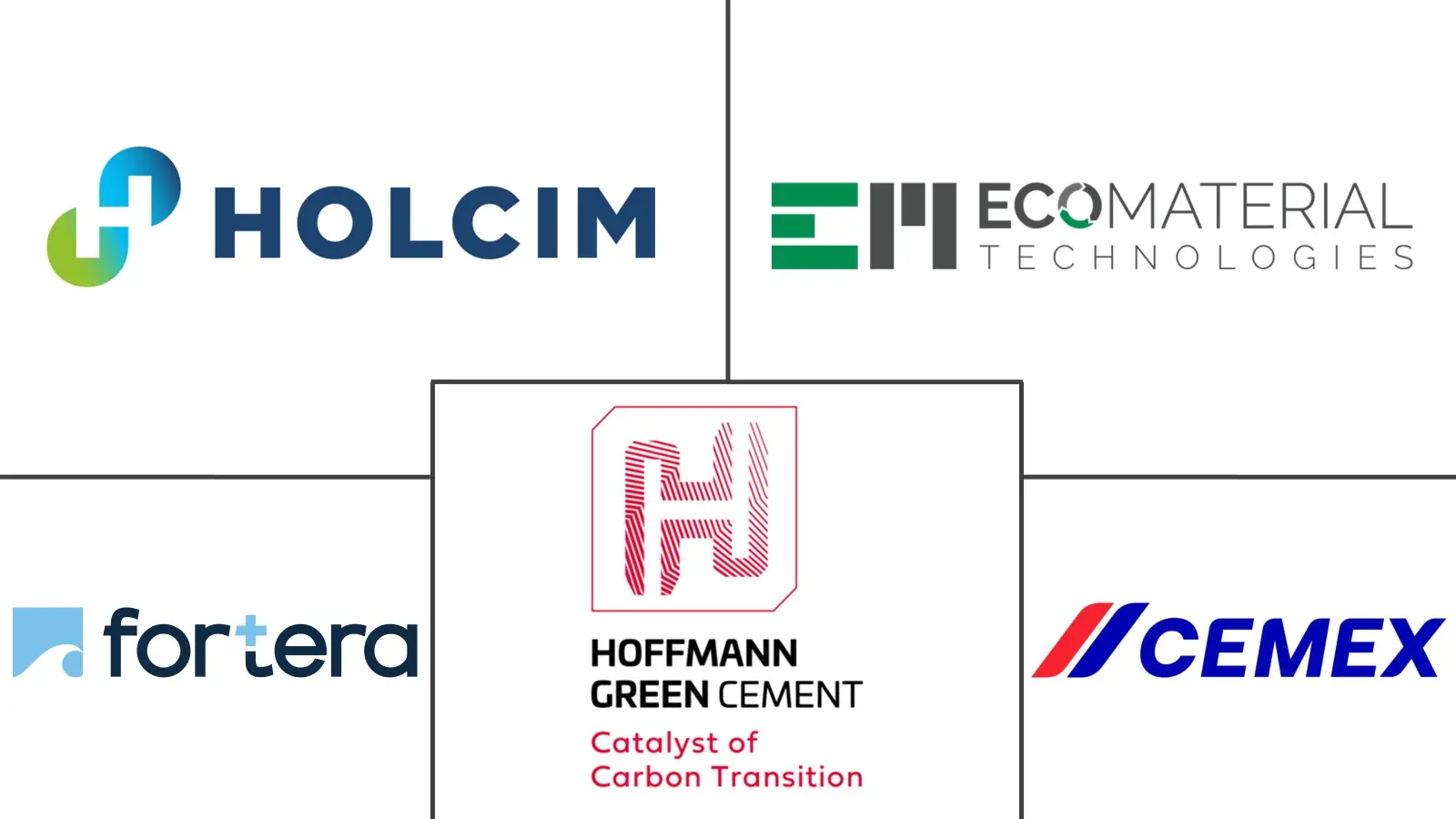North America Green Cement Market Size and Share
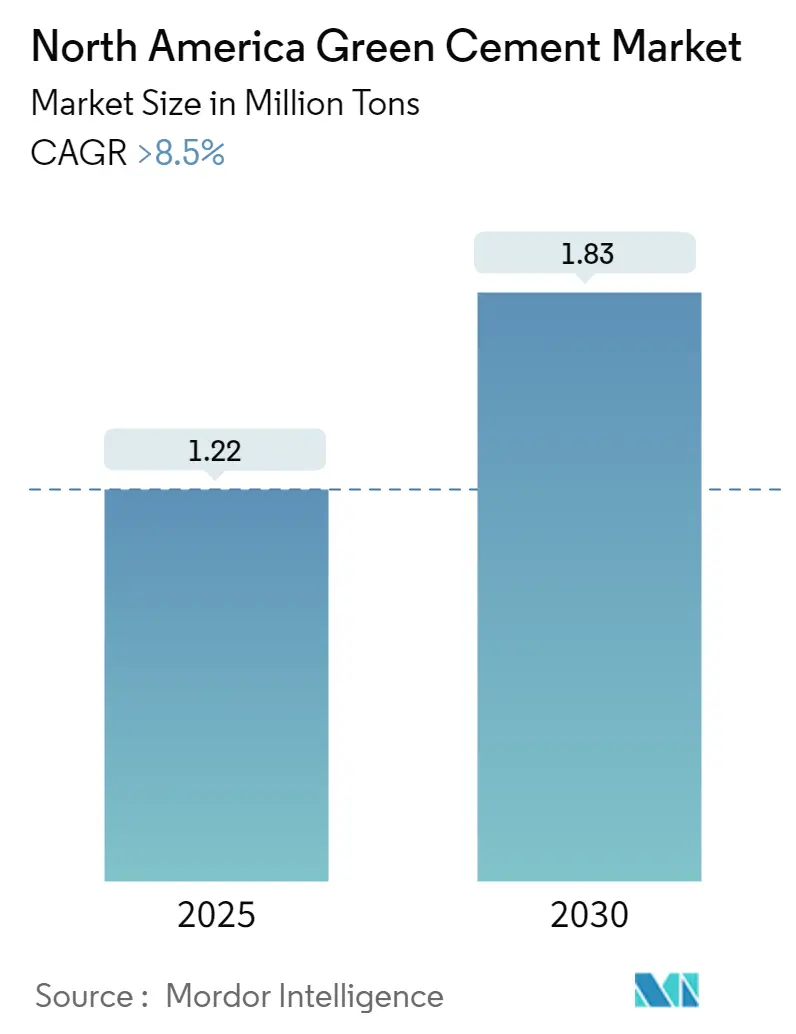
North America Green Cement Market Analysis by Mordor Intelligence
The North America Green Cement Market size is estimated at 1.22 million tons in 2025, and is expected to reach 1.83 million tons by 2030, at a CAGR of greater than 8.5% during the forecast period (2025-2030).
The COVID-19 pandemic in 2020 had a significant impact on the North American green cement market, initially causing disruption and setbacks such as demand slump, production cuts, revenue losses, supply chain disruptions, and increased raw material prices, among others. However, with government initiatives against the pandemic, the situation started to get better and thus helped the market to recover and grow.
Over the short term, growing green construction projects, favorable government policies for the usage of green cement, and the availability of raw materials are major factors driving the growth of the market studied.
However, the rising cost of construction is likely to restrain the growth of the studied market.
Nevertheless, research and development of novel products as raw materials for green cement will likely create lucrative growth opportunities for the global market.
The United States represents the largest market for green cement in the region, and due to the increasing adoption of green cement in its construction projects, its dominance will likely increase over the forecast period.
North America Green Cement Market Trends and Insights
Residential Construction to Dominate the Market
- Green cement is gaining traction for the construction of green buildings as it is eco-friendly, consumes industrial waste, reduces carbon dioxide emissions, and requires less energy for production.
- In addition, green cement is highly durable and long-lasting and exhibits excellent strength, durability, resilience, crack resistance, high corrosion resistance, and low chloride permeability.
- In the United States, Canada, and Mexico, green residential construction is growing rapidly. The countries have recently launched various residential construction projects focusing on green construction.
- In 2022, GP Vivienda, one of Mexico’s biggest real estate developers and construction companies, built twelve residential complexes across the Monterrey metropolitan area in Nuevo León. The company used 50,000 m3 of green concrete from Holcim, which helped them achieve a carbon dioxide emissions reduction of 30%.
- Moreover, the construction industry has also been growing steadily in Mexico. According to the International Trade Organization, the Mexican construction industry's average annual growth is anticipated to reach 3.1% between 2022 and 2025.
- The Mexican Chamber of Construction Industry announced that the construction industry was estimated to have grown by 6% in 2022. The growth could also increase the confidence of private investors since most projects are expected to be carried out using their funding, thus supporting improvements in investments across the industry in 2023.
- According to the Canada Green Building Council (CAGBC), around 5,145 projects across the country certified by LEED (Leadership in Energy and Environmental Design) were built in the last two decades. Out of these, 362 were ranked in the platinum category, which is the highest LEED status. 57 projects have also attained the CAGBC’s Zero Carbon Building standards. Thus, green construction is a promising market in Canada.
- According to Statistics Canada, the value of building permits for residential buildings in Canada for the first five months of 2023 was USD 32.36 million. In terms of number of dwellings created, the figures stood at 103,895 units. In 2022, the number of dwelling units constructed stood at 277,593 units. Looking at the trends in residential construction in the country, the construction output has been fairly consistent over the past 2 years.
- Courtesy of these developments in the North American region, the demand for green cement from the residential sector will continue to grow in the forecast period.
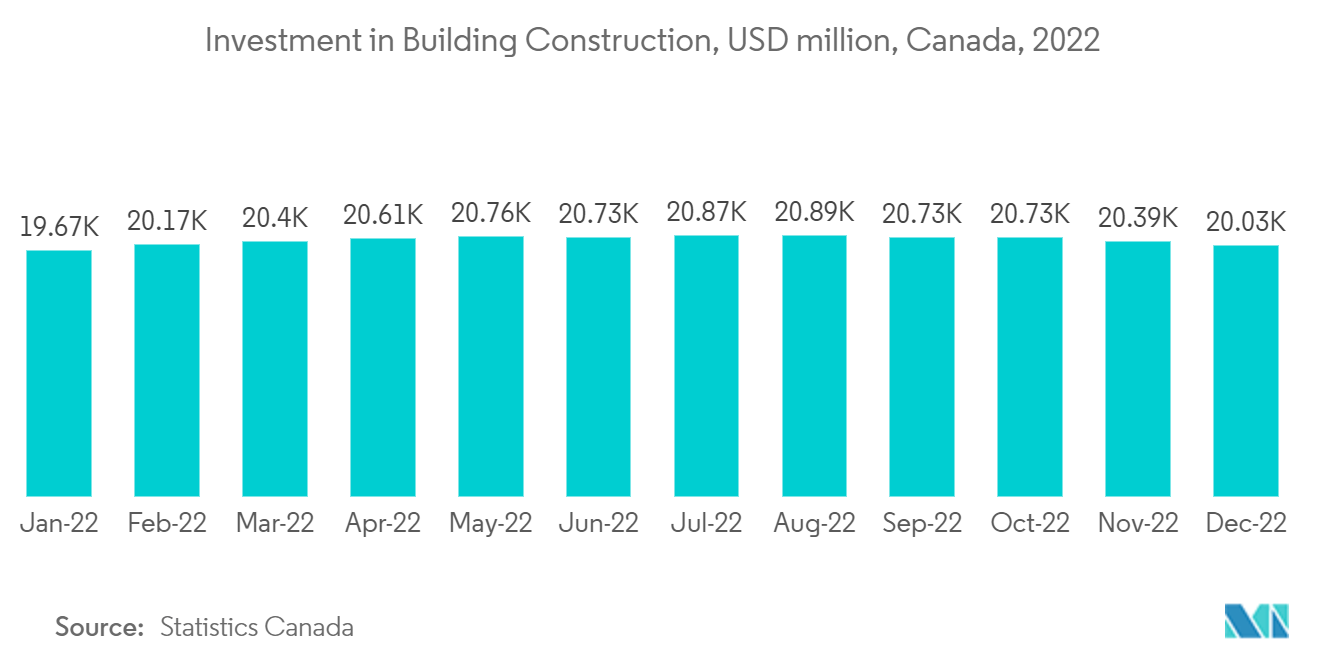
United States to Dominate the Market
- Since United States President Joe Biden signed the Inflation Reduction Act in August 2022, numerous public and private investments were realized in climate solutions, including those focused on the building sector, which accounts for about 40% of global greenhouse gas emissions.
- The bill allocated USD 391 billion toward climate solutions, including new tax credits for residential energy retrofits, energy efficiency rebates, updated building energy codes, and deductions for commercial buildings that reduce their energy consumption.
- The move has brought a positive change to the green construction industry. This will lead to increased consumption of green cement in the country. Moreover, the expansion of the residential and non-residential construction markets will also likely drive the market studied.
- According to the AIA (American Institute of Architects) Construction Consensus Forecast Panel, nonresidential building construction spending expanded to 5.4% in 2022. Further, U.S. expenditure on new private non-residential buildings peaked at over USD 539 billion in 2022. By the end of 2023, all the principal commercial, industrial, and institutional categories were to witness at least reasonably healthy gains.
- Following are some major non-residential construction projects in the United States which are estimated to be completed by 2023 :
- Fontainebleau, Las Vegas - The 67-story hotel, gaming, meeting, and entertainment project construction will include 3,700 hotel rooms, 550,000 square feet of convention and meeting space, as well as dining, gaming, retail, and experiences focused on health and wellness.
- Amazon HQ2 - The first phase of the new Amazon HQ2 office space at National Landing, which began in January 2020, will be completed by 2023.
- According to the US Census Bureau, in the past 5 years, from 2018 to 2022, the total value of construction increased by almost 40%, with residential construction accounting for more than a 60% increase in the total value of construction.
- The total value of residential construction in 2022 was USD 927 billion, an increase of 14.6% over 2021. The total value of non-residential construction in 2022 was USD 921 billion, an increase of 9% over 2021.
- Consequently, the growing construction industry in the United States is going to add to the demand for green cement over the forecast period.
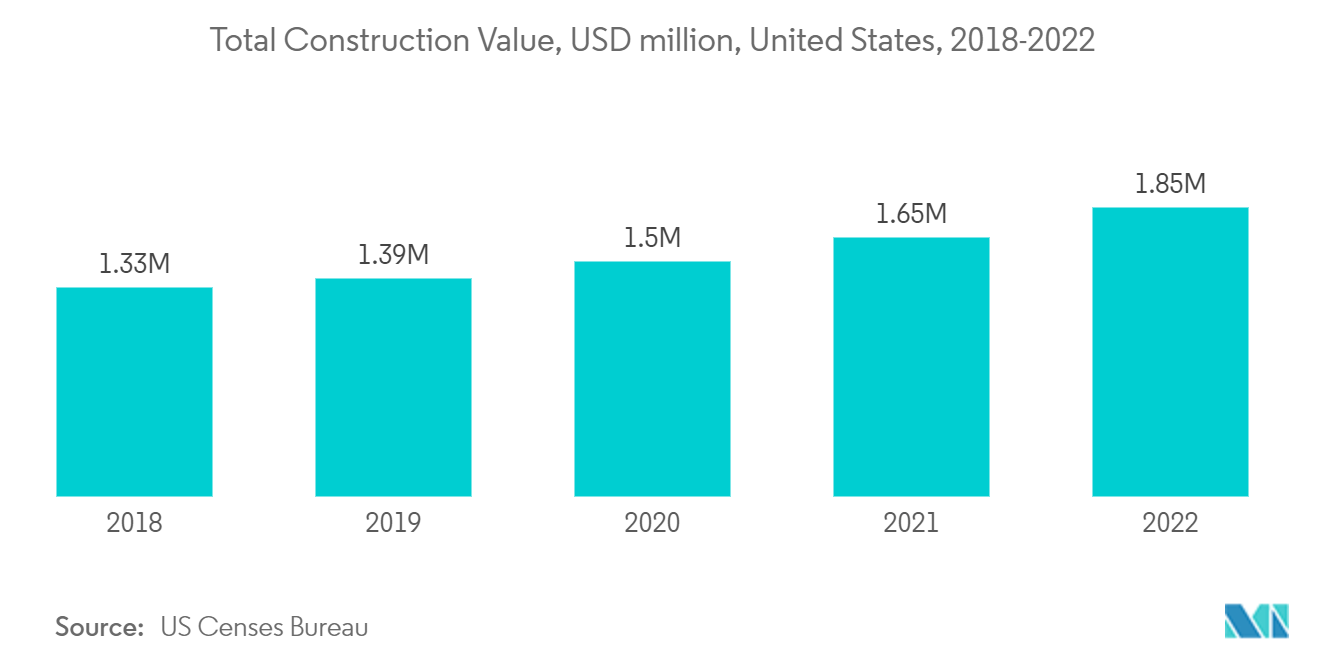
Competitive Landscape
The North American green cement market is partially consolidated in nature. The major players (not in any particular order) include Eco Material Technologies, HOLCIM, Hoffmann Green Cement Technologies, CEMEX, S.A.B. de C.V., and Fortera Corporation, among others.
North America Green Cement Industry Leaders
-
Eco Material Technologies
-
Hoffmann Green Cement Technologies
-
Fortera Corporation
-
HOLCIM
-
CEMEX, S.A.B. de C.V.
- *Disclaimer: Major Players sorted in no particular order
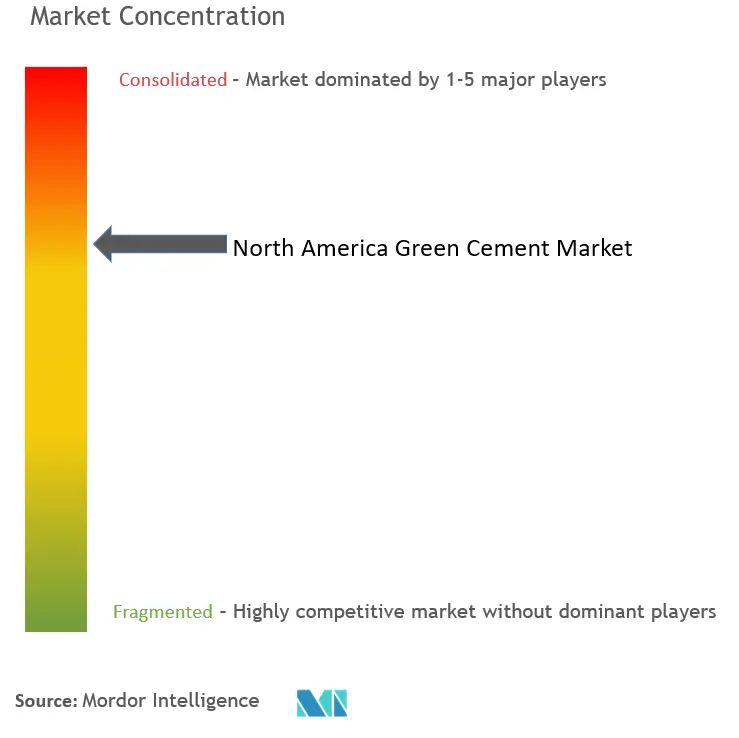
Recent Industry Developments
- November 2023: CRH agreed on a major deal in Texas two months after moving its primary listing from London to New York. It announced that it bought assets from Martin Marietta for USD 2.1 billion.
- September 2023: Fortera Corporation aimed to fire up as many as seven commercial plants in the next five years with USD 1 billion in financing to fund its aggressive expansion.
- June 2023: Eco Material Technologies, in partnership with Hive 3D, as part of The Casitas @ The Halles project, unveiled the first 3D-printed homes made using almost zero carbon cement. Hive 3D used Eco Material Technologie's green cement called PozzCEM Vite as part of the construction, replacing 100% of Portland cement in concrete.
- March 2023: Holcim Mexico started production of its Fuerte Más reduced-CO2 cement at its cement production units in Macuspana and Tabasco, with a combined rate of production of 60,000 tons per year. The company replaced some of the clinker in the cement with locally sourced minerals from Southeast Mexico, and the new cement now offers 50% reduced carbon dioxide emissions and 10% higher physical performance than ordinary Portland cement.
- November 2022: Titan America LLC announced the full conversion of its cement plants to the production of Type IL portland-limestone cement, a low-carbon construction material. Titan America LLC partnered with customers in New York City, New Jersey, Virginia, North Carolina, and Florida to champion the low carbon cement for use in their concrete.
- September 2022: The German building materials company formerly named HeidelbergCement rebranded to Heidelberg Materials.
- February 2022: Holcim and Eni announced the establishment of a collaboration to develop an innovative technology to produce green cement from captured carbon. The partnership involves the creation of a demonstration plant with the aim of testing the reduction of the CO2 footprint of cement and the integration of this innovative solution in cement plants.
North America Green Cement Market Report Scope
Green cement is an environmentally friendly cement that reduces carbon dioxide emissions during manufacturing. Green cement is mostly produced from raw materials that are discarded as waste from industrial processes. Some of the major raw materials utilized in the production of green cement include the slag from the blast furnace and fly ash. Magnesium oxychloride cement, calcium sulfoaluminate cement, geopolymer cement, and sequestrated carbon cement are some examples of green cement.
North America's green cement market is segmented by product type, construction sector, and geography (United States, Canada, and Mexico). By product type, the market is segmented into fly ash-based, slag-based, limestone-based, silica fume-based, and other product types (geopolymers and recycled aggregates). By the construction sector, the market is segmented into residential and non-residential. The report also covers the market size and forecasts for the North American green cement market in 3 countries across the North American region.
For each segment, the market sizing and forecasts have been done on the basis of volume (tons).
| Fly Ash-based |
| Slag-based |
| Limestone-based |
| Silica fume-based |
| Other Product Types (Geopolymers and Recycled Aggregates) |
| Residential |
| Non-residential |
| United States |
| Canada |
| Mexico |
| Product Type | Fly Ash-based |
| Slag-based | |
| Limestone-based | |
| Silica fume-based | |
| Other Product Types (Geopolymers and Recycled Aggregates) | |
| Construction Sector | Residential |
| Non-residential | |
| Geography | United States |
| Canada | |
| Mexico |
Key Questions Answered in the Report
How big is the North America Green Cement Market?
The North America Green Cement Market size is expected to reach 1.22 million tons in 2025 and grow at a CAGR of greater than 8.5% to reach 1.83 million tons by 2030.
What is the current North America Green Cement Market size?
In 2025, the North America Green Cement Market size is expected to reach 1.22 million tons.
Who are the key players in North America Green Cement Market?
Eco Material Technologies, Hoffmann Green Cement Technologies, Fortera Corporation, HOLCIM and CEMEX, S.A.B. de C.V. are the major companies operating in the North America Green Cement Market.
What years does this North America Green Cement Market cover, and what was the market size in 2024?
In 2024, the North America Green Cement Market size was estimated at 1.12 million tons. The report covers the North America Green Cement Market historical market size for years: 2019, 2020, 2021, 2022, 2023 and 2024. The report also forecasts the North America Green Cement Market size for years: 2025, 2026, 2027, 2028, 2029 and 2030.
Page last updated on:
North America Green Cement Market Report
Statistics for the 2025 North America Green Cement market share, size and revenue growth rate, created by Mordor Intelligence™ Industry Reports. North America Green Cement analysis includes a market forecast outlook for 2025 to 2030 and historical overview. Get a sample of this industry analysis as a free report PDF download.
